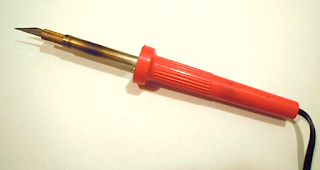I can't claim to know a thing about making a candle from a mould, although my sister is really good at it. I also can't claim to know a thing about sculpting a pre-made candle, but I figured it was the most I could aspire to without some actual instruction.
The earliest candles were produced in China around 200 B.C., and were made of whale blubber. In Europe, it would take another 600 years for candles to arrive, largely because olive oil was so readily available for use in lamps. European candles were made of fat, tallow and, if you were wealthy, beeswax.
In 1830, paraffin was distilled for the first time, changing candlemaking forever. Paraffin was inexpensive, burned fairly cleanly, and didn't reek as much as many other types of candle. Today, most candles are made of either beeswax or paraffin, although soy and other materials are now used as well.
Before the advent of electric lights, candles and oil lamps were used for illumination. Today, candles are used largely for ambience, in various rituals and ceremonies, or to scent a room—and, of course, as emergency lighting if the power goes out.
For today's elephant, I bought this cheap candle which is supposed to be scented, and supposed to smell of "orange". Well, I guess it does, if they meant "orange crayon". On the other hand, cheap scented candles can be pretty vile, so I'll take the crayon smell.
I decided to start by inscribing a general outline with a paring knife. Not being a very skilled sculptor, and being a completely incompetent whittler, the bar for today was set pretty low.
Once that was done, I used a heated blade. This was pretty messy, but that was mostly because I hadn't anticipated the way the wax would drip all over the place. The blade was also not the best tool to have chosen.
I scraped away some more wax with the paring knife, and tried again with a couple of different tips: one with a point, and one that's like a mini-spatula. These worked a bit better; however, the thing to remember is that there's a certain volume of wax that has to go somewhere. This means that it's either going to drip onto the countertop, or onto your hands, or into the parts of the candle that had already been carved away.
It took about 45 minutes to carve this, which was all the time I wanted to spend on it. Given the way the melted wax gushes, it can be slightly frustrating to maintain your design without recarving. I also, it must be admitted, got a little bored.
I don't hate the final result, but it's far more clunky than I had envisioned. I may try this again when I have more time, but given my previous experience with encaustic, I'm beginning to sense that wax and I are not necessarily going to get along.
Elephant Lore of the Day
In the late ninth and early eight centuries B.C., Assyria's Queen Semiramis faced off against the army of India's King Stabrobates with an estimated 100,000 chariots, 5,000 cavalry, and 300,000 foot soldiers. She also, according to one account, fielded thousands of war elephants.
When faced with India's army and its own war elephants, however, the Assyrian soldiers panicked. Most ran away, but some defected to the Indian side—where they told an interesting tale.
It turned out that Assyria's war elephants weren't elephants at all, but camels. During the two years of preparation for her Indian campaign, Semiramis had ordered elephant costumes to be made for thousands of her camels.
Having selected 300,000 dark oxen, she had the hides sewn together and stuffed with hay to make fairly realistic elephants. Inside each elephant, there was a man to operate it, and a camel to provide locomotion.
To Support Elephant Welfare
Elephant sanctuaries
(this Wikipedia list allows you to click through to information on a number of sanctuaries around the world)
Performing Animal Welfare Society
Zoocheck
Bring the Elephant Home
African Wildlife Foundation
Performing Animal Welfare Society
Zoocheck
Bring the Elephant Home
African Wildlife Foundation












No comments:
Post a Comment